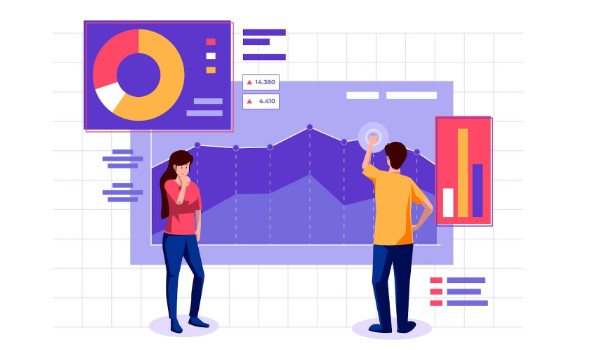Share Share Share Share Email How are businesses making decisions today? Are they relying on outdated, slow processes or leveraging cutting-edge technology to stay competitive? In a world where data is being generated at an unprecedented rate, how can companies harness that information to make smarter, faster decisions? According to a recent report by Deloitte, 63% of businesses are increasing their investment in data analytics to improve decision-making. Moreover, companies that use data-driven decision-making are five times more likely to make faster and three times more likely to execute decisions effectively. These statistics highlight the growing importance of technology in the decision analytics process and the opportunity it presents for businesses to upgrade their strategies for success.
Decision analytics is crucial in shaping these choices, ensuring organizations operate efficiently, minimize risks, and seize opportunities. With the continuous evolution of technology, businesses can significantly upgrade their decision analytics process. By leveraging technology, companies can enhance data-driven insights, improve decision-making, and streamline operations, ultimately driving growth and innovation.

The Role of Decision Analytics in Business Decision analytics uses data, statistical models, algorithms, and machine learning to support decision-making. It provides insights based on historical and real-time data, helping businesses forecast outcomes, identify trends, and make informed choices. The more accurate and comprehensive the analytics, the better the company can anticipate future needs, optimize resources, and adapt to changing market conditions.
However, many organizations still rely on traditional methods for decision-making, such as manual analysis or simple spreadsheets, which can be slow, error-prone, and limited in scope. These outdated approaches often fail to keep up with data’s increasing volume and complexity. This is where technology can make a significant impact.
How Technology Can Upgrade Decision Analytics Integrating modern technologies into the decision analytics process can dramatically improve decision-making quality, speed, and reliability. Here are some key technologies that businesses can leverage to upgrade their decision analytics processes: 1. Artificial Intelligence (AI) and Machine Learning AI and machine learning have revolutionized the way businesses approach decision analytics.
By using algorithms that can learn from data, businesses can automate complex decision-making processes and uncover patterns that were previously difficult to identify. These technologies can analyze vast amounts of data in real time, making it possible to generate timely and accurate insights. Machine learning models can continuously improve as they are exposed to more data, enabling businesses to make better predictions and adapt their strategies accordingly.
AI-powered tools can also provide recommendations based on past outcomes, offering decision-makers more confidence. For instance, a retail business can use machine learning algorithms to predict customer behavior and optimize inventory management. 2.
Big Data Analytics Another significant advantage that technology brings to decision analytics is the ability to analyze large datasets, often referred to as big data. With big data tools, organizations can process and analyze information from various sources, such as customer interactions, social media, market trends, and internal operations. By combining structured and unstructured data, businesses can get a more comprehensive view of the factors influencing their decisions.
Big data analytics enables companies to track performance metrics in real-time, detect emerging trends, and identify anomalies or outliers that could signal potential problems. This level of insight allows organizations to make data-driven decisions more confidently, reducing the reliance on gut instincts or guesswork. 3.
Cloud Computing Cloud computing provides businesses with scalable, on-demand access to computing resources and data storage, making implementing advanced decision analytics tools easier. Instead of maintaining costly on-premise infrastructure, companies can leverage cloud platforms to process and analyze data faster and more efficiently. Cloud-based decision analytics platforms also facilitate collaboration, as teams across different locations can access and work on the same data in real-time.
Moreover, cloud technology enables businesses to access the latest software updates and innovations without needing constant manual upgrades. This helps organizations stay on the cutting edge of analytics without the burden of maintaining hardware or software systems. 4.
Business Intelligence (BI) Tools Business Intelligence (BI) tools have been a staple of decision analytics for years, but with the advancements in technology, these tools have become more sophisticated and user-friendly. Modern BI tools offer interactive dashboards, real-time data visualization, and advanced reporting capabilities that allow decision-makers to easily interpret complex datasets. For organizations looking for a powerful and flexible decision analytics platform, Analytica provides advanced features for modeling, scenario analysis, and decision support, making it an excellent choice for those wanting to dive deeper into predictive analytics.
By integrating AI, machine learning, and big data capabilities, BI tools can provide deeper insights and predictive analytics, enabling businesses to forecast future trends and optimize operations. These tools also make it easier for non-technical users to interact with data, democratizing organizational decision-making. 5.
Automation and Workflow Management Tools Automation technologies can streamline decision analytics by reducing manual intervention and human error. For example, automated reporting systems can generate regular performance reports based on pre-defined parameters, freeing up valuable time for decision-makers to focus on strategy. Workflow management tools can also ensure that the right people are involved at each stage of the decision-making process, facilitating faster, more coordinated decisions.
Additionally, automation allows for continuous monitoring of business processes, enabling organizations to detect issues before they escalate. This can be particularly valuable in high-stakes healthcare, finance, and manufacturing industries, where timely decisions can have significant consequences. The Benefits of Leveraging Technology in Decision Analytics By incorporating advanced technologies into their decision analytics processes, organizations can experience a range of benefits, including: Improved Accuracy: Technology can reduce human errors and biases, leading to more accurate data analysis and decision-making.
Faster Decisions: Technology can significantly speed up the decision-making process by processing large volumes of data quickly, allowing businesses to respond more rapidly to market changes. Enhanced Insights: AI, machine learning, and big data analytics provide deeper and more granular insights, helping businesses understand complex patterns and trends that may have gone unnoticed. Cost Savings: Automation and cloud-based tools can reduce the need for manual labor and costly infrastructure, leading to significant cost savings.
Scalability: As businesses grow, technology enables them to scale their decision analytics processes to handle larger volumes of data and more complex decisions. Conclusion Integrating modern technology into the decision analytics process is not just a trend; it’s necessary for businesses looking to stay competitive in an increasingly data-driven world. AI, machine learning, big data, cloud computing, BI tools, and automation are all powerful technologies that can help businesses make smarter, faster, and more accurate decisions.
By embracing these tools, organizations can improve their decision-making processes, enhance operational efficiency, and drive growth and success. Related Items: Analytics Process , Upgrading Decision Share Share Share Share Email Comments.
Technology

Upgrading Decision Analytics Process by Leveraging Technology

How are businesses making decisions today? Are they relying on outdated, slow processes or leveraging cutting-edge technology to stay competitive? In a world where data is being generated at an unprecedented rate, how can companies harness that information to make smarter, faster decisions? According to a recent report by Deloitte, 63% of businesses are increasing [...]The post Upgrading Decision Analytics Process by Leveraging Technology appeared first on TechBullion.














